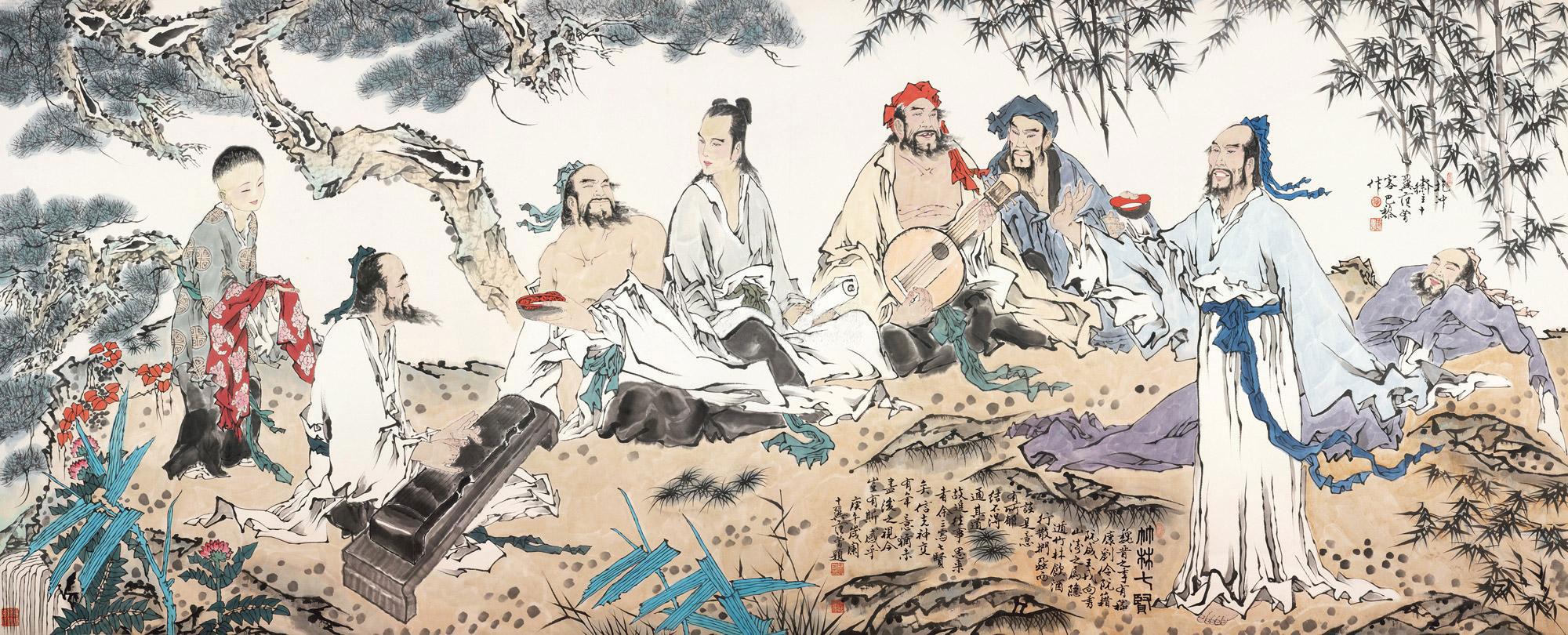The six dynasties: A prosperous epoch in Chinese literary history

The Seven Sages of the Bamboo Grove refers to seven distinguished Chinese scholars, writers and musicians in the six dynasties. They exerted a great influence on Chinese poetry, art and overall culture.
The six dynasties (222-589) refer to six Chinese dynasties in Southern China during the periods of the Three Kingdoms (220-280), Jin Dynasty (265-420), and Southern and Northern Dynasties (420-589), which was an important era in the history of Chinese literature. Gorgeous poems, rapidly developing supernatural tales, rhyming essays, flourishing literary criticism, precise historical records and ancient classics constitute its rich cultural heritage.
Exploring literary issues
On the southern slope of Zhongshan Mountain, not far away from the Altar in the Northern Suburb in Nanjing, which was built under the reign of Xiaowu Emperor Liu Jun of the Southern Dynasties (420-589), is the historical site of the Upper Dinglin Temple. This is where Liu Xie (c. 465-520) created the influential book on Chinese literary aesthetics The Literary Mind and the Carving of Dragons. The site is now used for the preservation of cultural relics in Nanjing. Although the Upper Dinglin Temple has disappeared, broken stone retaining walls, drainage ditches and scattered fences in the site still attract visitors who respect and love Liu and his influential book.
The Literary Mind and the Carving of Dragons was the first well-organized monograph on literary theory in ancient China. Its appearance demonstrated that Chinese literary theory and literary criticism had already established an integrated system. In addition, Selections of Refined Literature by Xiao Tong (501-531), Grades of Poetry by Zhong Rong (c. 468-c. 518) and The Record of the Classification of Old Painters by Xie He (479-502) were significant works of Chinese literature in the periods of the six dynasties.
The six-dynasties culture was rich and colorful that broke through the rigid pattern exclusively dominated by Confucianism in the Han Dynasty (206 BCE-220 CE). Also, various categories of culture and art during this period represented a boom in development. In the areas of literature, poetry, calligraphy, painting and others, a large number of outstanding literary critics emerged in the six dynasties. They mentioned many theories, methods and guidelines, which have exerted a far-reaching influence.
Among works on literary theory and literary criticism in the six dynasties, a new ideological trend emerged, trying to distinguish literature from other disciplines in order to explore literature’s characteristics, classifications, rules of literary creation and the value of literature. In the Southern Dynasties, literature held a new position which was independent of other disciplines. According to the biography of Lei Cizong in the Book of Song, Emperor Wen Liu Yihong of the Southern Dynasties commanded that schools be opened, which taught students literature, Confucianism, metaphysics and historiography. Literature had the same position with other three disciplines at that time, which showed a marked improvement in the position of literature.
Expressing personal feelings
During the periods of the six dynasties, poetry creation entered into a literati-oriented, self-conscious and personalized phase. Large numbers of poets, abundant poems and diverse poetic styles reflected an unprecedented boom. Themes were broadened at that time. For example, Xie Lingyun (385-433) introduced natural landscapes into his poetry and accomplished the shift from classical Chinese poems to landscape poems, which added infinite vitality to poetry creation. Tao Yuanming (352 or 365-427) initially created pastoral poems using a plain and natural poetic style, which built upon the poetry aesthetics from the Han and Wei (220-265) dynasties.
Influenced by the independence of literature, literary creation in the six dynasties became less attached to political civilization, and instead shifted toward focusing on people’s personal lives. Literary creation broke through the restrictions of political civilization and showed social life and people’s inner worlds with more freedom and depth. Big fu in the Han Dynasty, which gradually evolved into small lyrical fu during the six dynasties, is a good example. As a prose poem, big fu adopts methods of prose and mainly focuses on describing capital cities, palaces and hunting. But small lyrical fu put an emphasis on poetic sentiment and expressing poets’ personal emotions.
Ancient Chinese poets attempted to realize beauty in form, including techniques such as rhythm and antithesis along with improvements in the metrical pattern of poetry. Following this trend, Chinese poetry was perfected in the six dynasties. New styles took shape and modern styles began to grow, laying a foundation for a golden age of poetry in the Tang Dynasty (618-907).
In addition to poetry, all other literary forms in the six dynasties developed at a rapid speed and radiated extraordinary splendor in the history of Chinese literature. Bian Xiaoxuan (1924-2009), a famous scholar in literature and history, once indicated that literature in the six dynasties not only inherited past traditions but also broke new ground for the future in the history of Chinese literary development. But, certainly, it is not strange that literature in the six dynasties also had its flaws.

 PRINT
PRINT CLOSE
CLOSE